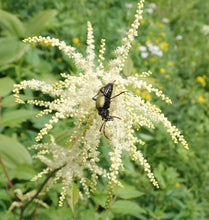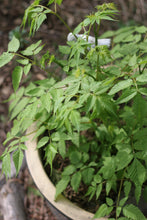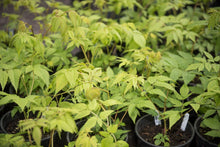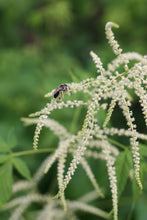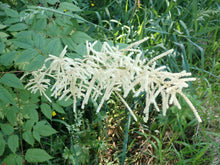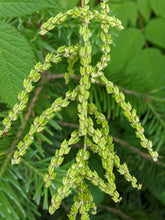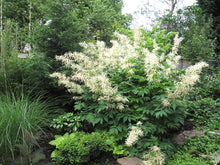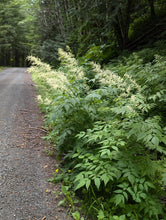
Aruncus dioicus var. acuminatus
With an impressive array of landscape and ecological functions that will rival even your favorite ornamental plants, goatsbeard is a must in your woodland or semi-shady habitat garden. It’s decorative finely-cut foliage emerges each year in April to create a bold, showy effect. By early summer, goatsbeard explodes into elegant plumes of tiny white flowers. With its arching feathery blooms, it's a lovely background, screen or border plant - but is also showy enough to hold center stage.
Goatsbeard is also a superb habitat plant, attracting countless insect species, including native bees, syrphid flies, teeny tiny beetles, and — if you’re lucky — mourning cloak and Dusky Azure Butterflies (it’s host to the latter). Small birds can make use of the seeds if spent flowers are left to overwinter.
Also note - there are male and female plants with the male form having flowers that are more feathery and upright than the female, which tend to droop. The female plants produce a smaller, greenish-white flower and tiny brown seed capsules.
- Plant type/canopy layer: deciduous, perennial, herbaceous plant
- Size at maturity: 3-7' tall, 3-5' wide
- Light requirements: part sun to full shade
- Moisture requirements: moist soil
- Growth rate/ease: medium growth rate, easy to grow
- Bloom time: May - August
- Wildlife support: flowers attract and provide nectar to hummingbirds, adult butterflies, bees and other insect pollinators; overall plant attracts and supports beneficial and pest eating insects and is a caterpillar host plant and larval food source for native butterflies and moths
- Native habitat/range: common along streams, in moist meadows and forests, but also sometimes in disturbed areas such as roadsides, throughout western Oregon, Washington and northern California including the Cascades. Portland Plant List - yes.
- Special features & uses: hummingbird and pollinator favorite
Gardening with Goatsbeard: Goatsbeard is a hardy perennial that dies back each winter, preparing to gorgeously return each spring. It’s tolerant of variable light and soil conditions but does particularly well in acidic soils with high organic matter. It does best with at least half-day shade, and tolerates sun provided the soil is moist enough. It spreads slowly by rhizomes to form attractive patches, so be sure to give it space to expand. Grow it with associates (those that naturally grow together and depend on each other), including Douglas-fir, western hemlock, western red cedar, vine maple, deer fern, maidenhair fern, inside-out flower, wild ginger, and western trillium. (Eileen M. Stark, Real Gardens Grow Natives)
Photo Credit 1 (flower/insect closeup): © John Brew, some rights reserved (CC-BY)
Photo Credit 2 & 4 (foliage in pot, insect visiting flowers): Karli Del Biondo, Beetles and Bees
Photo Credit 3 (in 1 gal pots): Hoddick Photography
Photo Credit 5 (flowers on stalk)
Photo Credit 6 (seeds): © John A Haskins, some rights reserved (CC-BY)
Photo Credit 7 (flowering in the garden): "Aruncus dioicus" by MeganEHansen is licensed under CC BY-SA 2.0.
Photo Credit 8 (flowering roadside): © David Anderson, some rights reserved (CC-BY)








